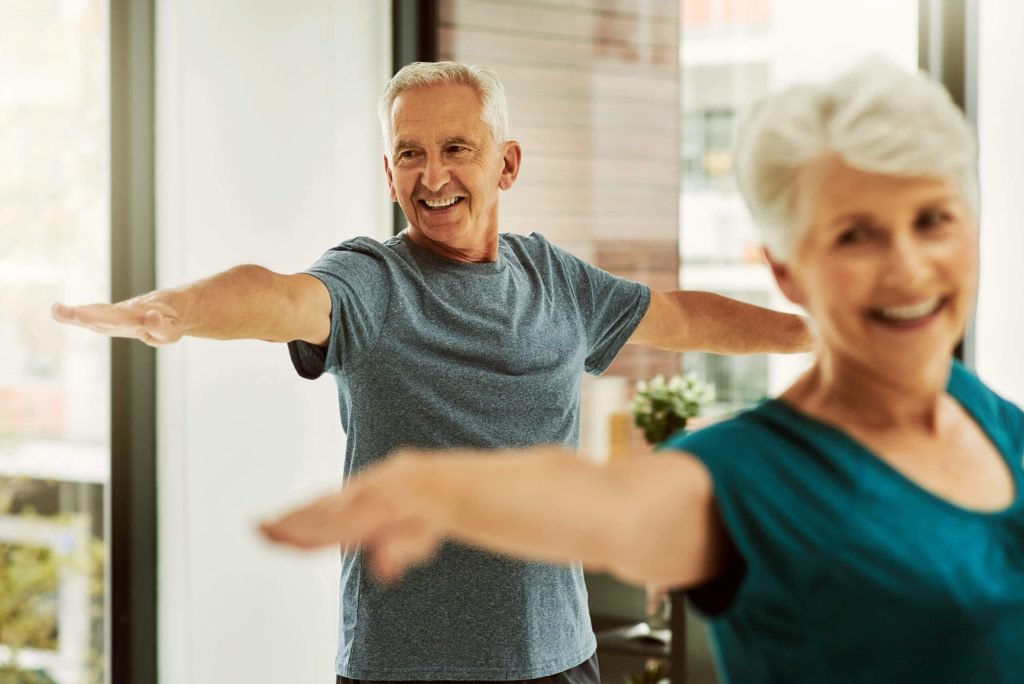
As we age, maintaining an active and healthy lifestyle becomes increasingly important. Regular exercise and physical activity can help seniors enhance their overall well-being, improve mobility, boost cognitive function, and reduce the risk of chronic diseases. By incorporating fitness into their daily routines, seniors can enjoy a higher quality of life and maintain their independence.
When it comes to staying active, it’s crucial to choose activities that are appropriate for your fitness level and health condition. Low-impact exercises such as walking, swimming, and cycling are excellent options for seniors, as they are gentle on the joints and promote cardiovascular health. Strength training exercises can help preserve muscle mass and bone density, reducing the risk of falls and fractures. Flexibility and balance exercises, like yoga and tai chi, can improve mobility and stability.
Prioritizing regular physical activity and staying consistent is key. Start with small goals and gradually increase the intensity and duration of your workouts. It’s essential to listen to your body and consult with a healthcare professional before starting any new exercise program. With the right approach, seniors can stay active, healthy, and enjoy the benefits of a fit lifestyle well into their golden years.
Benefits of Exercise for Older Adults
Exercise offers numerous benefits for older adults. Here are some key advantages:
- Improved Physical Health: Regular exercise helps maintain cardiovascular health, strengthen bones and muscles, and improve flexibility and mobility. It can also help manage conditions such as high blood pressure, diabetes, and arthritis.
- Enhanced Cognitive Function: Physical activity has been linked to improved cognitive function and reduced risk of cognitive decline and dementia. Exercise increases blood flow to the brain, stimulates the release of beneficial chemicals, and promotes neuroplasticity.
- Increased Independence: By improving strength, balance, and coordination, exercise reduces the risk of falls and injuries, thus promoting independence and confidence in daily activities.
- Weight Management: Regular physical activity helps maintain a healthy weight by burning calories, increasing metabolism, and preserving muscle mass. This can reduce the risk of obesity and related health issues.
- Mood and Mental Well-being: Exercise releases endorphins, the “feel-good” hormones, which can alleviate symptoms of depression, anxiety, and stress. It promotes a positive mood, boosts self-esteem, and enhances overall mental well-being.
- Social Engagement: Participating in group exercise classes or activities promotes social interaction and combats feelings of isolation or loneliness commonly experienced by older adults. This social engagement contributes to mental and emotional health.
- Better Sleep: Exercise can improve sleep quality and reduce the incidence of insomnia. Regular physical activity helps regulate sleep patterns, promotes relaxation, and increases overall sleep satisfaction.
- Increased Longevity: Studies have shown that regular exercise is associated with a longer lifespan. By reducing the risk of chronic diseases and maintaining overall health, exercise can contribute to a longer, healthier life.
It’s important for older adults to consult with healthcare professionals and tailor exercise routines to their individual needs and abilities. By incorporating regular physical activity into their lives, seniors can experience these benefits and enjoy a higher quality of life.
Fitness Tips for Adults to Stay Active and Healthy
Here are some fitness tips specifically tailored for seniors to stay active and healthy:
- Consult with a healthcare professional: Before starting any new exercise program, consult with your doctor or a qualified healthcare professional to ensure it is safe and suitable for your individual health condition and fitness level.
- Engage in a variety of activities: Incorporate a combination of cardiovascular exercises, strength training, flexibility exercises, and balance exercises into your routine. This helps to improve overall fitness, maintain muscle mass, and enhance mobility.
- Start slowly and progress gradually: Begin with low-impact activities and gradually increase the intensity, duration, and frequency of your workouts. This allows your body to adapt and reduces the risk of injury.
- Find activities you enjoy: Choose activities that you find enjoyable and that align with your interests. This increases motivation and makes it more likely that you’ll stick with your exercise routine in the long term.
- Stay hydrated: Drink plenty of water before, during, and after your workouts to stay properly hydrated, especially in hot weather or during intense exercise sessions.
- Warm up and cool down: Always start your exercise sessions with a gentle warm-up to prepare your muscles and joints for activity. Likewise, finish with a cool-down to gradually decrease your heart rate and stretch your muscles.
- Listen to your body: Pay attention to how your body feels during exercise. If you experience pain, dizziness, or any concerning symptoms, stop exercising and seek medical advice.
- Prioritize balance and flexibility: Incorporate exercises that improve balance and flexibility, such as yoga, tai chi, or simple stretching routines. These activities can help prevent falls and maintain mobility.
- Stay social: Engage in group exercise classes, join walking groups, or participate in activities with friends and family. This not only adds a social aspect to your fitness routine but also provides motivation and accountability.
- Don’t forget about rest and recovery: Allow your body adequate time to rest and recover between workouts. This allows for muscle repair and helps prevent overuse injuries.
Remember, consistency is key when it comes to fitness. Aim for regular exercise sessions, but also listen to your body and make adjustments as needed. By following these tips, seniors can maintain an active and healthy lifestyle well into their later years.
Tips to Stay Motivated
Staying motivated can sometimes be a challenge, but here are some tips to help you stay motivated in your fitness journey:
- Set clear and achievable goals: Define specific and realistic goals that you want to accomplish. Make sure they are measurable and time-bound. Having clear goals provides direction and gives you something to strive for.
- Find your “why”: Understand the reasons why you want to stay fit and healthy. Whether it’s improving your overall well-being, setting a positive example for your loved ones, or reaching a personal milestone, connecting with your deeper motivations can help fuel your motivation.
- Break it down: Break your larger fitness goals into smaller, manageable steps. This allows you to celebrate small victories along the way, keeping your motivation levels high. Focus on one step at a time and celebrate progress.
- Create a routine: Establish a consistent exercise routine that works for you. Schedule your workouts at a time that suits your lifestyle and stick to it. Having a routine makes it easier to stay on track and reduces the chances of skipping workouts.
- Find activities you enjoy: Engage in physical activities that you genuinely enjoy. Whether it’s dancing, swimming, hiking, or playing a sport, choosing activities that bring you joy increases the likelihood that you’ll stay motivated and committed to your fitness routine.
- Mix it up: Avoid boredom and monotony by varying your workouts. Try new exercises, explore different fitness classes, or change your workout environment. Adding variety keeps things fresh and exciting, helping to maintain motivation.
- Track your progress: Keep track of your workouts, milestones, and progress. This can be done through a fitness journal, an app, or simply using a calendar. Seeing how far you’ve come can be incredibly motivating and provide a sense of accomplishment.
- Find a workout buddy or support system: Exercise with a friend, join a fitness group, or find a workout buddy who shares similar goals. Having someone to exercise with can provide accountability, support, and make your workouts more enjoyable.
- Reward yourself: Treat yourself when you achieve certain milestones or reach your goals. It could be buying new workout gear, enjoying a favorite healthy meal, or treating yourself to a relaxing massage. These rewards serve as positive reinforcement and can help maintain motivation.
- Stay positive and celebrate progress: Focus on the progress you’ve made rather than being overly critical. Acknowledge and celebrate your achievements, no matter how small. Positive self-talk and a supportive mindset go a long way in staying motivated.
Remember that motivation may fluctuate at times, but with these strategies, you can cultivate a mindset that keeps you motivated and committed to your fitness journey.
Conclusion
In conclusion, staying motivated in your fitness journey is crucial for long-term success and enjoyment. By setting clear goals, finding your personal “why,” and breaking down your goals into manageable steps, you can create a roadmap for progress. Establishing a consistent routine, engaging in activities you enjoy, and adding variety to your workouts can help keep your motivation levels high. Tracking your progress, celebrating milestones, and rewarding yourself along the way serve as positive reinforcement. Surrounding yourself with a support system, whether it’s a workout buddy or a fitness community, can provide accountability and encouragement. Finally, maintaining a positive mindset, staying focused on your progress, and being kind to yourself are essential for sustaining motivation. By implementing these tips, you can overcome challenges, stay motivated, and continue on your path to a healthier and more active lifestyle. Remember, the journey is ongoing, and each step you take brings you closer to your goals.
